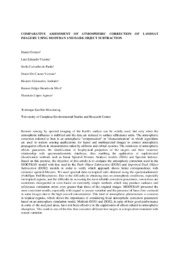Comparative assessment of atmospheric correction of Landsat imagery using Modtran and dark object subtraction.
Comparative assessment of atmospheric correction of Landsat imagery using Modtran and dark object subtraction.
Autoria: LOEBMANN, D. G. dos S. W.; VICENTE, L. E.; DE PAULA, S. C.; VICTORIA, D. de C.; ANDRADE, R. G.; SILVA, R. F. B. DA; AGNESE, M. L.
Resumo: Remote sensing by spectral imaging of the Earth's surface can be widely used, but only when the atmospheric influence is nullified and the data are reduced to surface reflectance units. The atmospheric correction referred to here is an atmospheric "compensation" or "characterization" in which algorithms are used in remote sensing applications for hyper and multispectral images to correct atmospheric propagation effects in measurements taken by airborne and orbital systems. The remission of atmospheric effects guarantees the identification of biophysical properties of the targets and their isonomic relationship with spectroradiometric databases, thus enabling the application of sophisticated classification methods such as linear Spectral Mixture Analysis models (SMA) and Spectral Indexes. Based on this premise, the objective of this article is to compare the atmospheric correction used in the MODTRAN model with that used in the Dark Object Subtraction (DOS1) and Improved Dark Object Subtraction (DOS2) models in order to verify which approach shows better correspondence with reference spectral libraries. We used spectral data on tropical soils obtained using the spectroradiometer (FieldSpec Full Resolution). Due to the difficulty in obtaining data on atmospheric conditions, especially for tropical regions, and the difficulty in accessing the most reliable correction procedures, corrections are sometimes disregarded or even based on extremely simple methods which may produce radiance and reflectance estimation errors even greater than tho se of the original images. MODTRAN presented the most consistent results, especially with regard to season variation and the presence of haze (low contrast) in some images due to the high aerosol concentration. This kind of atmospheric phenomenon is common in tropical regions, which shows the importance of considering local atmospheric correction parameters based on an atmosphere simulation model. Methods DO S1 and DOS2, in spite of their good performance in some of the analyzed areas, have not been effective in the suppression of effects related to atmospheric absorption. This work is one of the few that considers different test targets in a tropical environment with season variation.
Ano de publicação: 2012
Tipo de publicação: Resumo em anais e proceedings
Unidade: Embrapa Territorial
Palavras-chave: Remote sensing, Spectral imaging
Observações
1 - Por padrão são exibidas publicações dos últimos 20 anos. Para encontrar publicações mais antigas, configure o filtro ano de publicação, colocando o ano a partir do qual você deseja encontrar publicações. O filtro está na coluna da esquerda na busca acima.
2 - Para ler algumas publicações da Embrapa (apenas as que estão em formato ePub), é necessário ter, no celular ou computador, um desses softwares gratuitos. Sistemas Android: Google Play Livros; IOS: iBooks; Windows e Linux: software Calibre.
Acesse outras publicações
Acesse a Base de Dados da Pesquisa Agropecuária (BDPA) para consultar o acervo completo das bibliotecas da Embrapa.

